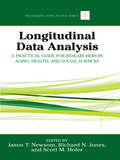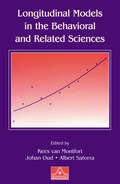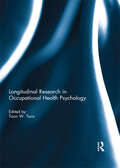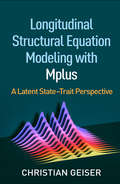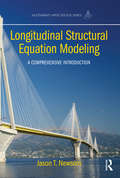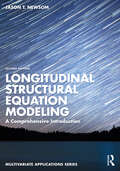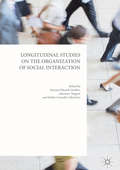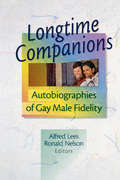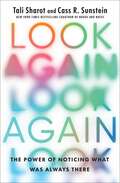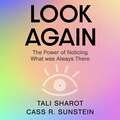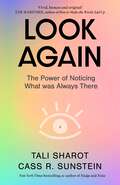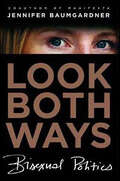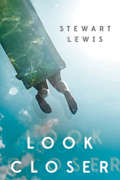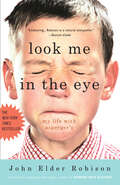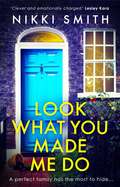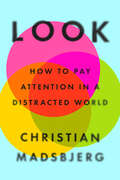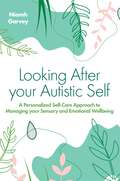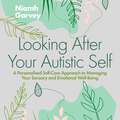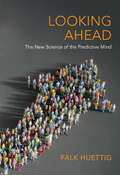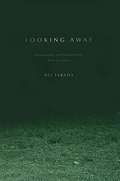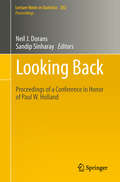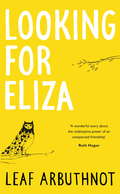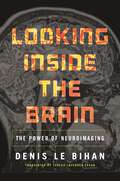- Table View
- List View
Longitudinal Data Analysis: A Practical Guide for Researchers in Aging, Health, and Social Sciences (Multivariate Applications Series)
by Scott M. Hofer Jason T. Newsom Richard N. JonesThis book provides accessible treatment to state-of-the-art approaches to analyzing longitudinal studies. Comprehensive coverage of the most popular analysis tools allows readers to pick and choose the techniques that best fit their research. The analyses are illustrated with examples from major longitudinal data sets including practical information about their content and design. Illustrations from popular software packages offer tips on how to interpret the results. Each chapter features suggested readings for additional study and a list of articles that further illustrate how to implement the analysis and report the results. Syntax examples for several software packages for each of the chapter examples are provided at www.psypress.com/longitudinal-data-analysis. Although many of the examples address health or social science questions related to aging, readers from other disciplines will find the analyses relevant to their work. In addition to demonstrating statistical analysis of longitudinal data, the book shows how to interpret and analyze the results within the context of the research design. The methods covered in this book are applicable to a range of applied problems including short- to long-term longitudinal studies using a range of sample sizes. The book provides non-technical, practical introductions to the concepts and issues relevant to longitudinal analysis. Topics include use of publicly available data sets, weighting and adjusting for complex sampling designs with longitudinal studies, missing data and attrition, measurement issues related to longitudinal research, the use of ANOVA and regression for average change over time, mediation analysis, growth curve models, basic and advanced structural equation models, and survival analysis. An ideal supplement for graduate level courses on data analysis and/or longitudinal modeling taught in psychology, gerontology, public health, human development, family studies, medicine, sociology, social work, and other behavioral, social, and health sciences, this multidisciplinary book will also appeal to researchers in these fields.
Longitudinal Models in the Behavioral and Related Sciences (European Association of Methodology Series)
by Kees Van MontfortThis volume reviews longitudinal models and analysis procedures for use in the behavioral and social sciences. Written by distinguished experts in the field, the book presents the most current approaches and theories, and the technical problems that may be encountered along the way. Readers will find new ideas about the use of longitudinal analysis in solving problems that arise due to the specific nature of the research design and the data available. Longitudinal Models in the Behavioral and Related Sciences opens with the latest theoretical developments. In particular, the book addresses situations that arise due to the categorical nature of the data, issues related to state space modeling, and potential problems that may arise from network analysis and/or growth-curve data. The focus of part two is on the application of longitudinal modeling in a variety of disciplines. The book features applications such as heterogeneity on the patterns of a firm’s profit, on house prices, and on delinquent behavior; non-linearity in growth in assessing cognitive aging; measurement error issues in longitudinal research; and distance association for the analysis of change. Part two clearly demonstrates the caution that should be taken when applying longitudinal modeling as well as in the interpretation of the results. This new volume is ideal for advanced students and researchers in psychology, sociology, education, economics, management, medicine, and neuroscience.
Longitudinal Multivariate Psychology (Multivariate Applications Series)
by Emilio Ferrer Steven M. Boker Kevin J. GrimmThis volume presents a collection of chapters focused on the study of multivariate change. As people develop and change, multivariate measurement of that change and analysis of those measures can illuminate the regularities in the trajectories of individual development, as well as time-dependent changes in population averages. As longitudinal data have recently become much more prevalent in psychology and the social sciences, models of change have become increasingly important. This collection focuses on methodological, statistical, and modeling aspects of multivariate change and applications of longitudinal models to the study of psychological processes. The volume is divided into three major sections: Extension of latent change models, Measurement and testing issues in longitudinal modeling, and Novel applications of multivariate longitudinal methodology. It is intended for advanced students and researchers interested in learning about state-of-the-art techniques for longitudinal data analysis, as well as understanding the history and development of such techniques.
Longitudinal Research in Occupational Health Psychology
by Toon W. TarisOccupational health psychology (OHP) involves the application of psychology to improving the quality of work life and to promoting and protecting the safety, health and well-being of employees. Achieving these aims requires researchers and practitioners to possess in-depth knowledge of the processes that are presumed to bring about the desired outcomes. To date, most studies in OHP have relied on cross-sectional designs in examining these processes. In such designs all variables of interest are measured simultaneously. Although this has generated useful insights in how particular phenomena are associated, such designs cannot be trusted when it comes to drawing causal inferences: association is not causation. This book therefore focuses on longitudinal research designs in OHP, whereby the concepts of interest are measured several times, offering much stronger evidence for causal relationships. The authors focus on design issues in longitudinal research (such as the number of measurements chosen, and the length of the time lags between these measurements), and illustrate these issues in the context of applied research on topics such as the work-family interface, conflict at work, and employee well-being. By doing so this volume provides a state-of-the-art overview of current research in OHP, both in terms of its findings and methodologies.This book is based on a special issue of the journal Work & Stress.
Longitudinal Structural Equation Modeling with Mplus: A Latent State-Trait Perspective (Methodology in the Social Sciences)
by Christian GeiserAn in-depth guide to executing longitudinal confirmatory factor analysis (CFA) and structural equation modeling (SEM) in Mplus, this book uses latent state–trait (LST) theory as a unifying conceptual framework, including the relevant coefficients of consistency, occasion specificity, and reliability. Following a standard format, chapters review the theoretical underpinnings, strengths, and limitations of the various models; present data examples; and demonstrate each model's application and interpretation in Mplus, with numerous screen shots and output excerpts. Coverage encompasses both traditional models (autoregressive, change score, and growth curve models) and LST models for analyzing single- and multiple-indicator data. The book discusses measurement equivalence testing, intensive longitudinal data modeling, and missing data handling, and provides strategies for model selection and reporting of results. User-friendly features include special-topic boxes, chapter summaries, and suggestions for further reading. The companion website features data sets, annotated syntax files, and output for all of the examples.
Longitudinal Structural Equation Modeling: A Comprehensive Introduction (Multivariate Applications Series)
by Jason T. NewsomThis comprehensive resource reviews structural equation modeling (SEM) strategies for longitudinal data to help readers see which modeling options are available for which hypotheses. The author demonstrates how SEM is related to other longitudinal data techniques throughout. By exploring connections between models, readers gain a better understanding of when to choose one analysis over another. The book explores basic models to sophisticated ones including the statistical and conceptual underpinnings that are the building blocks of the analyses.? Accessibly written, research examples from the behavioral and social sciences and results interpretations are provided throughout. The emphasis is on concepts and practical guidance for applied research rather than on mathematical proofs. New terms are highlighted and defined in the glossary. Figures are included for every model along with detailed discussions of model specification and implementation issues.? Each chapter also includes examples of each model type, comment sections that provide practical guidance, model extensions, and recommended readings. Highlights include: Covers the major SEM approaches to longitudinal analysis in one resource. Explores connections between longitudinal SEM models to enhance integration.? Numerous examples that help readers match research questions to appropriate analyses and interpret results. Reviews practical issues related to model specification and estimation to reinforce connections.? Analyzes continuous and discrete (binary and ordinal) variables throughout for breadth not found in other sources. Reviews key SEM concepts for those who need a refresher (Ch. 1).? Emphasizes how to apply and interpret each model through realistic data examples. Provides the book’s data sets at www.longitudinalsem.com along with the Mplus and R-lavaan syntax used to generate the results. Introduces the LISREL notation system used throughout (Appendix A).? The chapters can be read out of order but it is best to read chapters 1 – 4 first because most of the later chapters refer back to them. The book opens with a review of latent variables and analysis of binary and ordinal variables. Chapter 2 applies this information to assessing longitudinal measurement invariance.? SEM tests of dependent means and proportions over time points are explored in Chapter 3, and stability and change, difference scores, and lagged regression are covered in Chapter 4. The remaining chapters are each devoted to one major type of longitudinal SEM -- repeated measures analysis models, full cross-lagged panel models and simplex models, modeling stability with state-trait models, linear and nonlinear growth curve models, latent difference score models, latent transition analysis, time series analysis, survival analysis, and attrition. Missing data is discussed in the context of many of the preceding models in Chapter 13.? Ideal for graduate courses on longitudinal (data) analysis, advanced SEM, longitudinal SEM, and/or advanced data (quantitative) analysis taught in the behavioral, social, and health sciences, this text also appeals to researchers in these fields. Intended for those without an extensive math background, prerequisites include familiarity with basic SEM. Matrix algebra is avoided in all but a few places.
Longitudinal Structural Equation Modeling: A Comprehensive Introduction (Multivariate Applications Series)
by Jason T. NewsomLongitudinal Structural Equation Modeling is a comprehensive resource that reviews structural equation modeling (SEM) strategies for longitudinal data to help readers determine which modeling options are available for which hypotheses. This accessibly written book explores a range of models, from basic to sophisticated, including the statistical and conceptual underpinnings that are the building blocks of the analyses. By exploring connections between models, it demonstrates how SEM is related to other longitudinal data techniques and shows when to choose one analysis over another. Newsom emphasizes concepts and practical guidance for applied research rather than focusing on mathematical proofs, and new terms are highlighted and defined in the glossary. Figures are included for every model along with detailed discussions of model specification and implementation issues and each chapter also includes examples of each model type, descriptions of model extensions, comment sections that provide practical guidance, and recommended readings. Expanded with new and updated material, this edition includes many recent developments, a new chapter on growth mixture modeling, and new examples. Ideal for graduate courses on longitudinal (data) analysis, advanced SEM, longitudinal SEM, and/or advanced data (quantitative) analysis taught in the behavioral, social, and health sciences, this new edition will continue to appeal to researchers in these fields.
Longitudinal Studies on the Organization of Social Interaction
by Simona Pekarek Doehler Esther González-Martínez Johannes WagnerThis book advances our understanding of change over time in human social conduct, and represents the first consolidated effort to reveal how micro-analytic studies of social interaction address such issues. The book presents a collection of longitudinal studies drawing on conversation analysis across a variety of settings, practices, languages and timescales, and analyses the ways in which participants produce and deal with practices changing over time. This edited collection will interest students and scholars of conversation analysis, sociolinguistics, discourse analysis, interactional linguistics and pragmatics.
Longtime Companions: Autobiographies of Gay Male Fidelity
by Alfred Lees Ronald NelsonLongtime Companions: Autobiographies of Gay Male Fidelity provides a sophisticated alternative to “anything goes” gay literature. Challenging the stereotype that gay men are incapable of lasting and successful relationships, 15 long-term gay couples share slices of their own lives to give you insight into their present relationships, while some discuss life after their mates have passed on. You will find that their stories offer an inspirational and richly fulfilling alternative to an empty life of promiscuity that lacks true love.Through a treasury of autobiographical essays, Longtime Companions documents how committed gay male unions can be as enduring, nurturing, and diverse as heterosexual marriages and proves that loving commitments and life-sharing are not exclusive to heterosexual unions. A celebration of gay diversity, this book offers you insights from contributors of different ages, professions, geographic locations, and attitudes. You will learn the intimate details of the couples’lives, including: how they met their partners how soon they committed to each other how long the couples have been together--from 14 years to over 50 years their keys to leading successful, happy lives the ways in which their relationships fulfill their personal needs and contribute to community lifeYou will come to realize the true strength of these men’s relationships as you share in their struggles within a society that offers them little recognition or support for their successful relationships. Co-editor Alfred Lees explains in the introduction to Longtime Companions, “We’ve all worked diligently to make our partnerships sound, nurturing, and enduring. We’ve done this without any social motivation, largely without role models, in the face of ‘official’disapproval or contempt. We’ve told our stories here to refute--by the simple facts of our experience--the grotesque misrepresentation of gays as being incapable of stable, committed relationships.” Will add more. . . Through a treasury of autobiographical essays, Longtime Companions documents how committed gay-male unions can be as enduring, nurturing, and diverse as heterosexual marriages and proves that loving commitment and life-sharing are not exclusive to heterosexual unions. A celebration of gay diversity, contributors vary in age, profession, geographic location, and attitudes. You will learn the intimate details of the couples’lives, including: how they met their partners how soon they committed to each other how they managed to collaborate on successful, fulfilling lives how some have maintained their commitment as part of an open relationshipYou will come to realize the true strength of these men’s relationships as you share in their struggles within a society that offers them little recognition or support for their successful relationships. Co-Author Alfred Lees explains in the Introduction to Longtime Companions, “We’ve all worked diligently to make our partnerships sound, nurturing, and enduring. We&’ve done this without any social innovation, largely without role models, in the face of ‘official” disapproval or contempt. We’ve told our stories here to refute--by the simple facts of our experience--the grotesque misrepresentation of gays as being incapable of stable, committed relationships.”
Look Again: The Power of Noticing What Was Always There
by Cass R. Sunstein Tali SharotFor fans of Thinking Fast and Slow and The Power of Habit, a groundbreaking new study of how disrupting our well-worn routines, both good and bad, can rejuvenate our days and reset our brains to allow us to live happier and more fulfilling lives.Have you ever noticed that what is thrilling on Monday tends to become boring on Friday? Even exciting relationships, stimulating jobs, and breathtaking works of art lose their sparkle after a while. People stop noticing what is most wonderful in their own lives. They also stop noticing what is terrible. They get used to dirty air. They stay in abusive relationships. People grow to accept authoritarianism and take foolish risks. They become unconcerned by their own misconduct, blind to inequality, and are more liable to believe misinformation than ever before. But what if we could find a way to see everything anew? What if you could regain sensitivity, not only to the great things in your life, but also to the terrible things you stopped noticing and so don&’t try to change? Now, neuroscience professor Tali Sharot and Harvard law professor (and presidential advisor) Cass R. Sunstein investigate why we stop noticing both the great and not-so-great things around us and how to &“dishabituate&” at the office, in the bedroom, at the store, on social media, and in the voting booth. This groundbreaking work, based on decades of research in the psychological and biological sciences, illuminates how we can reignite the sparks of joy, innovate, and recognize where improvements urgently need to be made. The key to this disruption—to seeing, feeling, and noticing again—is change. By temporarily changing your environment, changing the rules, changing the people you interact with—or even just stepping back and imagining change—you regain sensitivity, allowing you to more clearly identify the bad and more deeply appreciate the good.
Look Again: The Power of Noticing What was Always There
by Cass R. Sunstein Tali SharotFor fans of Thinking, Fast and Slow and The Power of Habit, a groundbreaking new study of how disrupting our well-worn routines, both good and bad, can rejuvenate our days and reset our brains to allow us to live happier and more fulfilling lives.Have you ever noticed that what is thrilling on Monday tends to become boring on Friday? Even exciting relationships, stimulating jobs, and breathtaking works of art lose their sparkle after a while. People stop noticing what is most wonderful in their own lives. They also stop noticing what is terrible. They get used to dirty air. They stay in abusive relationships. People grow to accept authoritarianism and take foolish risks. They become unconcerned by their own misconduct, blind to inequality, and are more liable to believe misinformation than ever before.But what if we could find a way to see everything anew? What if you could regain sensitivity, not only to the great things in your life, but also to the terrible things you stopped noticing and so don't try to change?
Look Again: The Power of Noticing What was Always There
by Cass R. Sunstein Tali SharotFor fans of Thinking, Fast and Slow and The Power of Habit, a groundbreaking new study of how disrupting our well-worn routines, both good and bad, can rejuvenate our days and reset our brains to allow us to live happier and more fulfilling lives.Have you ever noticed that what is thrilling on Monday tends to become boring on Friday? Even exciting relationships, stimulating jobs, and breathtaking works of art lose their sparkle after a while. People stop noticing what is most wonderful in their own lives. They also stop noticing what is terrible. They get used to dirty air. They stay in abusive relationships. People grow to accept authoritarianism and take foolish risks. They become unconcerned by their own misconduct, blind to inequality, and are more liable to believe misinformation than ever before.But what if we could find a way to see everything anew? What if you could regain sensitivity, not only to the great things in your life, but also to the terrible things you stopped noticing and so don't try to change?
Look Both Ways: Bisexual Politics
by Jennifer BaumgardnerFor the acclaimed author and activist Jennifer Baumgardner, bisexuality has always been more than the "sexual non-preference of the '90s." In Look Both Ways, Baumgardner takes a close look at the growing visibility of gay and bisexual characters, performers, and issues on the national cultural stage. Despite the prevalence of bisexuality among Generation X and Y women, she finds that it continues to be marginalized by both gay and straight cultures, and dismissed either as a phase or a cop-out. With intimacy and humor, Baumgardner discusses her own experience as a bisexual, and the struggle she's undergone to reconcile the privilege she's garnered as a woman who is perceived as straight and the empowerment and satisfaction she's derived from her relationships with women.Part memoir, part pop-culture study, Look Both Ways connects the prominent dots of a bisexual community (Alix Kates Shulman, Ani DiFranco, Rebecca Walker, and, of course, Anne Heche) that Baumgardner argues have bridged feminist aims with those of the gay rights movement. Look Both Ways is a compelling and current study in bisexual lives lived secretly and openly, and an exploration of the lessons learned by writers, artists, and activists who have refused the either/or paradigm defended by both gay and straight communities.
Look Closer
by Stewart LewisEver since Tegan's father died while serving overseas, she's been numb. She quit the swim team, and without her best friend around to distract her, the weight of her father's death feels like it will crush her. Then one morning random letters are circled on her cereal box, letters which spell a name. Teagan doesn't know what to make of it, but tracks down that boy—only to witness him commit suicide. Teagan is devastated. But when she meets Edge, a friend of the dead boy, at least someone seems to understand how she feels.Except she sees another name...and another. And a pattern forms.Together, Teagan and Edge set out to find those people, to try to save them from their fate. With a renewed purpose, Tegan is determined to save lives that summer, just like her father used to. But can she save herself?
Look Me in the Eye: My Life with Asperger's (Thorndike Biography Ser.)
by John Elder RobisonEver since he was young, John Robison longed to connect with other people, but by the time he was a teenager, his odd habits—an inclination to blurt out non sequiturs, avoid eye contact, dismantle radios, and dig five-foot holes (and stick his younger brother, Augusten Burroughs, in them)—had earned him the label “social deviant.” It was not until he was forty that he was diagnosed with a form of autism called Asperger’s syndrome. That understanding transformed the way he saw himself—and the world. A born storyteller, Robison has written a moving, darkly funny memoir about a life that has taken him from developing exploding guitars for KISS to building a family of his own. It’s a strange, sly, indelible account—sometimes alien yet always deeply human.
Look What You Made Me Do: The most emotional, gripping gut punch of a thriller of 2021
by Nikki Smith'Creepy and unsettling - a tense, toxic read that will wrong-foot you at every turn' CHARLOTTE DUCKWORTHTwo people can keep a secret . . . if one of them is dead.Sisters Jo and Caroline are used to hiding things from each other. They've never been close - taking it in turns to feel on the outside of their family unit, playing an endless game of favourites.Jo envies Caroline's life - things have always come so easy to her. Then a family inheritance falls entirely to Jo, and suddenly now Caroline wants what Jo has. Needs it, even.But just how far will she go to get it?You'll be riveted by the new psychological suspense from Nikki Smith - a gripping gut-punch of a novel . . .* * * * * *Praise for Look What You Made Me Do:'Gripping and twisty, with real heart' LAURA MARSHALL'Emotional and sinister, with characters that draw you in and a story that keeps you turning the pages' JENNY QUINTANA'Terrifying and compulsive, deeply psychological, with wonderfully drawn characters and a satisfying conclusion' LISA BALLANTYNE'Fantastic - what Nikki's really good at is keeping the reader on the edge of her seat' EMMA CURTIS'I loved it' CHRIS WHITAKER'[One of] those moments where you realise the power of the written word' EMMA CHRISTIE'A deeply accomplished novel that combines razor-sharp characterisation with perfectly-pitched suspense. A fantastic, slow-burn thriller' PHILIPPA EAST
Look: How to Pay Attention in a Distracted World
by Christian MadsbjergA powerful exploration of how we pay attention that will transform the ways we connect with one another – at home, at work, and beyond. Paying attention is a crucial human skill, yet many of us have forgotten how to listen carefully and observe intentionally. Deluged by social media and hobbled by the increasing social isolation it fosters, we need to rediscover the deeply human ways we connect with others. Christian Madsbjerg, a philosopher and entrepreneur, understands this dilemma. To counteract it, he began a course at The New School in New York City called Human Observation, which lays out the ways that we can learn to pay attention more effectively. The course has been hugely popular since its inception, with hundreds of students filling waiting lists. In Look, Madsbjerg sets out the key observational skills needed to show how we can recapture our ability to pay attention. Drawing from philosophy, science, the visual arts, and his own life, he offers both practical insights and a range of tools for experiencing the world with greater richness and texture. The result is a dynamic approach to rethinking observation that helps all of us to see with more empathy, accuracy, and connection to others.
Looking After Your Autistic Self: A Personalised Self-Care Approach to Managing Your Sensory and Emotional Well-Being
by Niamh Garvey'I no longer try to mask my autism; I now work to support my autism'It is a myth that autistic children grow into 'less autistic' adults. In fact, many autistic adults feel more overwhelmed as they age as the stresses of social demands such as relationships, parenting, or the work environment increase.Niamh Garvey offers tips and tricks designed to reduce sensory and emotional stress and look after your autistic self. From understanding what's happening when the stress response kicks in to using the 'detective habit' to spot your individual strengths and triggers. What's more, every element of this book can be personalised to you.Featuring strategies including 'quick calm plans' for managing triggers and lived-experience advice on understanding emotional regulation, coping with sensory overload and how to look after your senses during intimacy, this guide is here to ensure that you don't just survive adulthood, you thrive in it.
Looking After Your Autistic Self: A Personalised Self-Care Approach to Managing Your Sensory and Emotional Well-Being
by Niamh Garvey'I no longer try to mask my autism; I now work to support my autism'Take charge of your needs including sensory self-care and emotional regulation for a calmer and happier life.It is a myth that autistic children grow into 'less autistic' adults. In fact, many autistic adults feel more overwhelmed as they age as the stresses of social demands such as relationships, parenting, or the work environment increase.Niamh Garvey offers tips and tricks designed to reduce sensory and emotional stress and look after your autistic self. From understanding what's happening when the stress response kicks in to using the 'detective habit' to spot your individual strengths and triggers. What's more, every element of this book can be personalised to you.Featuring strategies including 'quick calm plans' for managing triggers and lived-experience advice on understanding emotional regulation, coping with sensory overload and how to look after your senses during intimacy, this guide is here to ensure that you don't just survive adulthood, you thrive in it.(P)2023 Hodder & Stoughton Limited
Looking Ahead: The New Science of the Predictive Mind
by Falk HuettigDriven by the transformative idea that the brain operates as a predictive engine, this book offers a rigorous yet accessible introduction to predictive processing's core concepts while navigating major theories with depth and critical evaluation. Huettig incorporates historical contexts and maintains a critical stance, shedding light on the pros and cons of various approaches across the many academic disciplines that investigate future-oriented behavior. Looking Ahead is indispensable reading for early students of the science of prediction in psychology, cognitive science, neuroscience, linguistics, artificial intelligence and computer science, experts in related fields, and for anyone who has ever wondered why, as a species, we take so much interest in what lies ahead.
Looking Away: Phenomenality and Dissatisfaction, Kant to Adorno
by Rei TeradaRei Terada revisits debates about appearance and reality in order to make a startling claim: that the purpose of such debates is to police feelings of dissatisfaction with the given world.
Looking Back
by Neil J. Dorans Sandip SinharayIn 2006, Paul W. Holland retired from Educational Testing Service (ETS) after a career spanning five decades. In 2008, ETS sponsored a conference, Looking Back, honoring his contributions to applied and theoretical psychometrics and statistics. Looking Back attracted a large audience that came to pay homage to Paul Holland and to hear presentations by colleagues who worked with him in special ways over those 40+ years. This book contains papers based on these presentations, as well as vignettes provided by Paul Holland before each section. The papers in this book attest to how Paul Holland's pioneering ideas influenced and continue to influence several fields such as social networks, causal inference, item response theory, equating, and DIF. He applied statistical thinking to a broad range of ETS activities in test development, statistical analysis, test security, and operations. The original papers contained in this book provide historical context for Paul Holland's work alongside commentary on some of his major contributions by noteworthy statisticians working today.
Looking For Eliza
by Leaf Arbuthnot'Clever, warm and funny' - ADAM KAY'Beautifully rendered, thoughtful and original' - Pandora Sykes'A marvellous read' - Ruth HoganAda is a widowed writer, navigating loneliness in Oxford after the death of her husband. She has no children. No grandchildren. She fears she is becoming peripheral, another invisible woman. Eliza is a student at the university. She finds it difficult to form meaningful relationships after the estrangement of her mother and breakup with her girlfriend.After meeting through Ada's new venture, 'Rent-a-Gran', and bonding over Lapsang Souchong tea and Primo Levi, they begin to find what they're looking for in each other. But can they cast off their isolation for good? An exquisite story of connection and loss, and how a person can change another person's life. Full of heartache yet joyful and life-affirming, this is for fans of Normal People, Expectation and Sarah Winman's Tin Man.'Leaf's writing is warm and lyrically funny - she has an eye for details both sublime and ridiculous.Looking for Eliza is an intelligent and big-hearted read with the human condition at its core.' - Harriet Walker, The Times
Looking For Eliza
by Leaf Arbuthnot'Clever, warm and funny' - ADAM KAY'Beautifully rendered, thoughtful and original' - Pandora Sykes'A marvellous read' - Ruth HoganAda is a widowed writer, navigating loneliness in Oxford after the death of her husband. She has no children. No grandchildren. She fears she is becoming peripheral, another invisible woman. Eliza is a student at the university. She finds it difficult to form meaningful relationships after the estrangement of her mother and breakup with her girlfriend.After meeting through Ada's new venture, 'Rent-a-Gran', and bonding over Lapsang Souchong tea and Primo Levi, they begin to find what they're looking for in each other. But can they cast off their isolation for good? An exquisite story of connection and loss, and how a person can change another person's life. Full of heartache yet joyful and life-affirming, this is for fans of Normal People, Expectation and Sarah Winman's Tin Man.'Leaf's writing is warm and lyrically funny - she has an eye for details both sublime and ridiculous.Looking for Eliza is an intelligent and big-hearted read with the human condition at its core.' - Harriet Walker, The Times
Looking Inside the Brain: The Power of Neuroimaging
by Denis Le BihanThe remarkable story of how today's brain scanning techniques were developed, told by one of the field's pioneersIt is now possible to witness human brain activity while we are talking, reading, or thinking, thanks to revolutionary neuroimaging techniques like magnetic resonance imaging (MRI). These groundbreaking advances have opened infinite fields of investigation—into such areas as musical perception, brain development in utero, and faulty brain connections leading to psychiatric disorders—and have raised unprecedented ethical issues. In Looking Inside the Brain, one of the leading pioneers of the field, Denis Le Bihan, offers an engaging account of the sophisticated interdisciplinary research in physics, neuroscience, and medicine that have led to the remarkable neuroimaging methods that give us a detailed look into the human brain.Introducing neurological anatomy and physiology, Le Bihan walks readers through the historical evolution of imaging technology—from the x-ray and CT scan to the PET scan and MRI—and he explains how neuroimaging uncovers afflictions like stroke or cancer and the workings of higher-order brain activities, such as language skills. Le Bihan also takes readers on a behind-the-scenes journey through NeuroSpin, his state-of-the-art neuroimaging laboratory, and goes over the cutting-edge scanning devices currently being developed. Considering what we see when we look at brain images, Le Bihan weighs what might be revealed about our thoughts and unconscious, and discusses how far this technology might go in the future.Beautifully illustrated in color, Looking Inside the Brain presents the trailblazing story of the scanning techniques that provide keys to previously unimagined knowledge of our brains and our selves.
